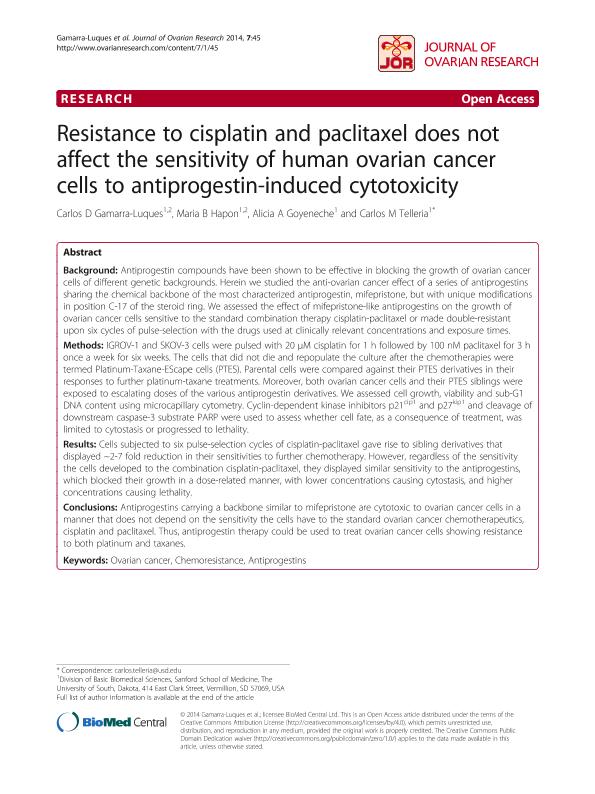Mostrar el registro sencillo del ítem
dc.contributor.author
Gamarra Luques, Carlos Diego

dc.contributor.author
Hapon, María Belén

dc.contributor.author
Goyeneche, Alicia
dc.contributor.author
Telleria, Carlos Marcelo

dc.date.available
2018-01-02T21:56:19Z
dc.date.issued
2014-04
dc.identifier.citation
Gamarra Luques, Carlos Diego; Hapon, María Belén; Goyeneche, Alicia; Telleria, Carlos Marcelo; Resistance to cisplatin and paclitaxel does not affect the sensitivity of human ovarian cancer cells to antiprogestin- induced cytotoxicity; BioMed Central; Journal of Ovarian Research; 7; 4-2014; 45-50
dc.identifier.issn
1757-2215
dc.identifier.uri
http://hdl.handle.net/11336/32077
dc.description.abstract
BACKGROUND: Antiprogestin compounds have been shown to be effective in blocking the growth of ovarian cancer cells of different genetic backgrounds. Herein we studied the anti-ovarian cancer effect of a series of antiprogestins sharing the chemical backbone of the most characterized antiprogestin, mifepristone, but with unique modifications in position C-17 of the steroid ring. We assessed the effect of mifepristone-like antiprogestins on the growth of ovarian cancer cells sensitive to the standard combination therapy cisplatin-paclitaxel or made double-resistant upon six cycles of pulse-selection with the drugs used at clinically relevant concentrations and exposure times.
METHODS: IGROV-1 and SKOV-3 cells were pulsed with 20 μM cisplatin for 1 h followed by 100 nM paclitaxel for 3 h once a week for six weeks. The cells that did not die and repopulate the culture after the chemotherapies were termed Platinum-Taxane-EScape cells (PTES). Parental cells were compared against their PTES derivatives in their responses to further platinum-taxane treatments. Moreover, both ovarian cancer cells and their PTES siblings were exposed to escalating doses of the various antiprogestin derivatives. We assessed cell growth, viability and sub-G1 DNA content using microcapillary cytometry. Cyclin-dependent kinase inhibitors p21(cip1) and p27(kip1) and cleavage of downstream caspase-3 substrate PARP were used to assess whether cell fate, as a consequence of treatment, was limited to cytostasis or progressed to lethality.
RESULTS: Cells subjected to six pulse-selection cycles of cisplatin-paclitaxel gave rise to sibling derivatives that displayed ~2-7 fold reduction in their sensitivities to further chemotherapy. However, regardless of the sensitivity the cells developed to the combination cisplatin-paclitaxel, they displayed similar sensitivity to the antiprogestins, which blocked their growth in a dose-related manner, with lower concentrations causing cytostasis, and higher concentrations causing lethality.
CONCLUSIONS: Antiprogestins carrying a backbone similar to mifepristone are cytotoxic to ovarian cancer cells in a manner that does not depend on the sensitivity the cells have to the standard ovarian cancer chemotherapeutics, cisplatin and paclitaxel. Thus, antiprogestin therapy could be used to treat ovarian cancer cells showing resistance to both platinum and taxanes.
dc.format
application/pdf
dc.language.iso
eng
dc.publisher
BioMed Central

dc.rights
info:eu-repo/semantics/openAccess
dc.rights.uri
https://creativecommons.org/licenses/by/2.5/ar/
dc.subject
Mifepristone
dc.subject
Ovarian Cancer
dc.subject
Paclitaxel
dc.subject
Cisplatino
dc.subject.classification
Otras Ciencias de la Salud

dc.subject.classification
Ciencias de la Salud

dc.subject.classification
CIENCIAS MÉDICAS Y DE LA SALUD

dc.title
Resistance to cisplatin and paclitaxel does not affect the sensitivity of human ovarian cancer cells to antiprogestin- induced cytotoxicity
dc.type
info:eu-repo/semantics/article
dc.type
info:ar-repo/semantics/artículo
dc.type
info:eu-repo/semantics/publishedVersion
dc.date.updated
2017-12-29T14:15:54Z
dc.journal.volume
7
dc.journal.pagination
45-50
dc.journal.pais
Reino Unido

dc.journal.ciudad
Londres
dc.description.fil
Fil: Gamarra Luques, Carlos Diego. University of South Dakota. Sanford School of Medicine. Division of Basic Biomedical Sciences; Estados Unidos. Consejo Nacional de Investigaciones Científicas y Técnicas. Centro Científico Tecnológico Conicet - Mendoza. Instituto de Medicina y Biología Experimental de Cuyo; Argentina
dc.description.fil
Fil: Hapon, María Belén. University of South Dakota. Sanford School of Medicine. Division of Basic Biomedical Sciences; Estados Unidos. Consejo Nacional de Investigaciones Científicas y Técnicas. Centro Científico Tecnológico Conicet - Mendoza. Instituto de Medicina y Biología Experimental de Cuyo; Argentina
dc.description.fil
Fil: Goyeneche, Alicia. University of South Dakota. Sanford School of Medicine. Division of Basic Biomedical Sciences; Estados Unidos
dc.description.fil
Fil: Telleria, Carlos Marcelo. University of South Dakota. Sanford School of Medicine. Division of Basic Biomedical Sciences; Estados Unidos. Consejo Nacional de Investigaciones Científicas y Técnicas. Centro Científico Tecnológico Conicet - Mendoza. Instituto de Medicina y Biología Experimental de Cuyo; Argentina
dc.journal.title
Journal of Ovarian Research
dc.relation.alternativeid
info:eu-repo/semantics/altIdentifier/url/https://ovarianresearch.biomedcentral.com/articles/10.1186/1757-2215-7-45
dc.relation.alternativeid
info:eu-repo/semantics/altIdentifier/url/https://www.ncbi.nlm.nih.gov/pmc/articles/PMC4007005/
dc.relation.alternativeid
info:eu-repo/semantics/altIdentifier/doi/http://dx.doi.org/10.1186/1757-2215-7-45
Archivos asociados
